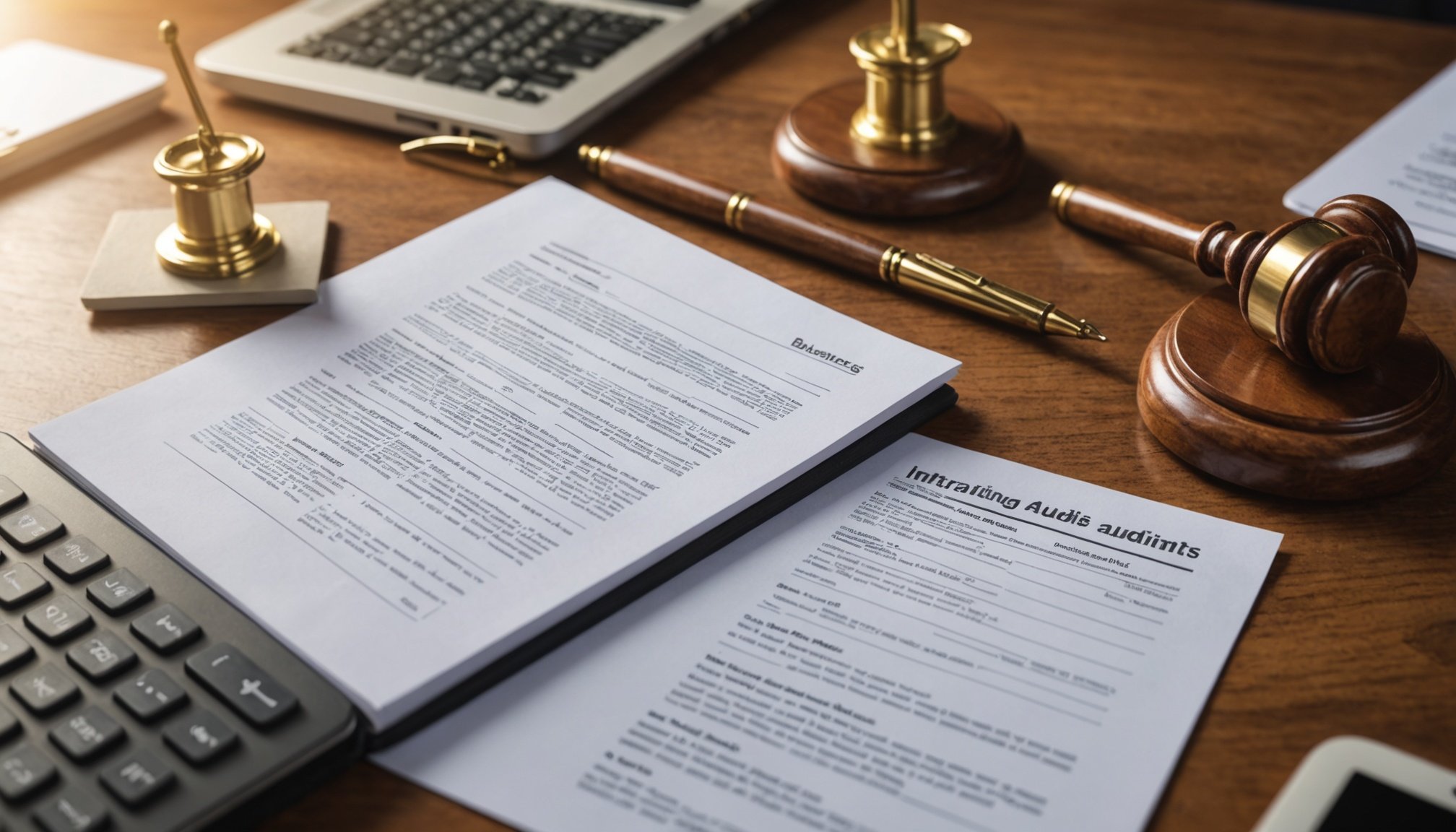Understanding Internal Audits
Internal audits are a crucial component of maintaining business compliance in the UK. They are self-evaluations conducted by a company to assess operational efficiency and ensure adherence to policies, regulations, and laws. By regularly performing internal audits, businesses can identify areas of non-compliance early on, reducing the risk of potential penalties and legal issues.
An internal audit involves a systematic examination of a company’s processes and controls. The audit process typically includes planning, execution, reporting, and follow-up actions. This rigorous approach helps organisations maintain accountability and transparency in their operations. It also enables them to make necessary adjustments to enhance efficiency and effectiveness, ultimately supporting long-term success.
This might interest you : Top UK Strategies to Ensure Legal Compliance When Engaging Third-Party Data Processors
To understand the value added by internal audits, it is critical to differentiate them from external audits. While both types of audits aim to evaluate financial integrity and operational effectiveness, they serve different purposes. Internal audits are conducted by the company’s own staff, focusing on improving internal processes and controls. External audits, on the other hand, are carried out by independent parties, primarily to verify the accuracy of financial statements.
In summary, internal audits are indispensable for businesses aiming to achieve UK business compliance. They not only support transparency but also foster continuous improvement within the organisation by meticulously scrutinising existing systems and practices.
Additional reading : Crucial legal insights for uk businesses aiming to launch a successful crowdfunding campaign
Legal Framework for Internal Audits in the UK
Navigating the UK legal framework for internal audits involves understanding specific audit regulations and compliance requirements set forth by legislation and regulatory bodies. This knowledge is essential for ensuring that audits are conducted efficiently and lawfully, meeting all pertinent compliance laws.
Key Legislation and Regulations
In the UK, several pieces of legislation influence internal auditing practices. The Companies Act 2006 is one significant legal document that sets standards for how companies must operate and report financial information. The UK Corporate Governance Code provides additional guidance, focusing on accountability and transparency within business operations. Complying with these regulations ensures that companies maintain integrity and transparency in their financial reporting and overall governance.
The Role of Regulatory Bodies
National regulatory bodies, such as the Financial Reporting Council (FRC), play a pivotal role in enforcing audit regulations. The FRC, for example, promotes high-quality corporate governance and reporting aimed at fostering investment. They oversee compliance with established guidelines, ensuring that internal audits align with legislative requirements across industries.
Consequences of Non-Compliance
Failing to adhere to compliance laws can lead to severe repercussions for organisations, including financial penalties, legal action, and reputational damage. Understanding the consequences is crucial for businesses to prioritise adherence to the UK legal framework, safeguarding against potential risks associated with oversight in audit compliance.
Preparing for an Internal Audit
Preparing for an internal audit can appear daunting, but a systematic approach helps ensure a seamless process. A crucial first step is developing an audit preparation plan, which often involves compiling a comprehensive checklist. This checklist should reflect the scope of the audit, encompassing all necessary aspects to be reviewed.
In terms of essential documentation, it is critical to gather financial records, operational manuals, compliance records, and organisational charts. These documents not only form the basis of the audit but also facilitate a transparent evaluation of your organisation’s processes and controls. Efficient audit preparation also requires confirming the availability and accessibility of these documents, ensuring they are updated and organised systematically.
Next, crafting a pre-audit checklist holds immense importance. A well-structured checklist aids in verifying that all required elements are prepared for assessment and that nothing is overlooked. Key elements to include are timelines for document submission and arrangements for interviews with pertinent team members.
To make the process more approachable, consider dividing tasks among dedicated team members. This not only distributes the workload but also encourages more thorough preparation for each aspect of the audit. By adhering to these structured steps, businesses can significantly streamline their internal audit process and enhance overall efficiency.
Conducting the Internal Audit
Efficient execution of an internal audit is crucial for assessing operations and improving processes. The audit execution comprises various techniques and requires thorough data collection.
Types of Audit Techniques
A variety of audit techniques can be employed to ensure comprehensive coverage of the internal audit. Some common methods include:
- Interviews: Engaging with employees to gather insights and confirm compliance.
- Document Inspection: Verifying procedures and standards through the review of reports and records.
Each technique plays a crucial role in identifying discrepancies or areas for improvement, allowing the auditor to form clear, precise conclusions.
Collecting and Analyzing Data
Data collection is at the heart of an effective audit execution. Accurate data collection relies on:
- Systematic methodologies to gather reliable information.
- Analytical methods to interpret the data correctly, ensuring the findings support the audit conclusions.
This process helps identify patterns, raise awareness of deficiencies, and improve strategic planning.
Team Roles in the Audit Process
A successful audit hinges on the effective collaboration of the audit team. Key roles include:
- Audit Manager: Guides the team and ensures alignment with objectives.
- Lead Auditor: Directs the audit activities and maintains the quality of work.
- Team Members: Collect and analyze data, implementing specific audit techniques to reach accurate conclusions.
Understanding and executing these roles diligently strengthens the overall audit process.
Identifying and Addressing Compliance Issues
In the realm of audits, compliance issues are common hurdles. They often emerge due to lapses in adhering to regulatory standards, inconsistent documentation practices, or failure to update processes according to new legal requirements. These issues can lead to significant risks if not managed effectively.
To tackle compliance issues, a well-structured risk management strategy is paramount. This involves identifying potential areas of non-compliance, evaluating their impact, and prioritizing areas that require immediate attention. By conducting a thorough risk assessment, organisations can better predict threats and implement preventive measures.
Once compliance issues are identified during audits, formulating and implementing corrective actions becomes crucial. These steps aim to rectify infringements and enhance future compliance. Corrective actions may include revising existing protocols, conducting training for staff on updated compliance standards, or enhancing documentation procedures.
Implementing corrective actions is not a one-time fix but part of an ongoing improvement process. Monitoring the effectiveness of these actions over time ensures that they effectively minimise the possibility of recurrence. Additionally, regular reviews and updates of compliance policies help maintain adherence to ever-evolving regulations, safeguarding the organisation from potential legal ramifications. Ultimately, addressing compliance issues with diligence fortifies an organisation’s integrity and operational success.
Reporting and Follow-Up
In the realm of audit reporting, structuring an audit report is crucial for clarity and comprehension. It should begin with an executive summary that encapsulates the core audit findings. Providing a clear outline of the objectives, scope, and methodology enhances transparency. Each section of the audit report must detail specific findings, associated risks, and recommended actions.
Communicating Findings to Stakeholders
Effectively communicating audit findings to stakeholders is pivotal. Start by identifying the key stakeholders who will be impacted by the findings. It’s essential to tailor the communication style to the audience—some stakeholders may prefer technical details, while others might focus on financial implications. Utilize visuals like charts or graphs to convey complex data succinctly, enhancing stakeholder engagement and understanding.
Importance of Follow-Up Actions
Follow-up actions are significant in ensuring that audit findings lead to actionable change. After presenting the audit report, it’s vital to develop an action plan that outlines steps for implementing the recommendations. Assign responsibility to specific individuals or teams and set deadlines to track progress. Regular updates and reviews serve as checkpoints, ensuring that all recommendations are addressed effectively. Ensuring a robust follow-through fosters an environment of continuous improvement within the organization, enhancing its operations and risk management capabilities.
Best Practices for Successful Internal Audits
Implementing audit best practices is crucial for ensuring effective operations and reliable results within a company. Establishing an audit culture begins with leadership commitment, which must support and promote compliance and integrity within every department. This culture is essential, as it drives continuous improvement and enables teams to proactively identify and address issues before they escalate.
Techniques to foster continuous improvement in audits include regular training sessions and workshops for the audit team. Integrating feedback mechanisms after each audit ensures that both strengths and areas needing improvement are clearly identified. Furthermore, maintaining an open dialogue between auditors and different departments can lead to enhanced collaboration and understanding, thus making audit processes more refined and insightful.
Measuring audit effectiveness requires specific and quantifiable metrics. Common metrics include the percentage of audit findings that are resolved within a specified period and the ratio of significant issues identified versus those remediated successfully. These metrics help in assessing the success of audit activities and inform future improvements.
Additionally, employing technology and data analytics can markedly improve the precision of audits. Advanced analytical tools provide deeper insights, making the audit process more efficient and comprehensive. By following these practices, an organization cultivates a proactive and robust audit framework that propels business growth and accountability.
Challenges in Internal Audits and How to Overcome Them
Navigating internal audits can be fraught with challenges, yet understanding these hurdles can pave the way to successful outcomes. One common issue is the complexity of data management, where large volumes of data need precise scrutiny. This can lead to overwhelming workloads and increased risk of errors. Another frequent challenge is maintaining compliance with ever-evolving regulations, which demands constant vigilance and adaptability from auditors.
To effectively navigate these issues, several strategies can be employed. Firstly, embracing technology such as audit management software can streamline processes and enhance accuracy. These tools are crucial for automating repetitive tasks, thus reducing manual errors and saving valuable time. Secondly, regular training sessions for audit teams ensure that auditors remain informed about the latest regulatory changes, boosting their competency and ability to deliver credible audits.
Moreover, vast arrays of resources are available to aid in overcoming these obstacles. Consulting with industry experts and joining professional audit associations provide valuable insights and support. Furthermore, online platforms and forums offer a plethora of resources for guidance, enabling auditors to share experiences and solutions. By utilising these audit solutions and support, internal audit teams can effectively manage the multifaceted nature of their roles, ensuring comprehensive audit success.











